Arizona is a landlocked state in the southwestern U.S. that borders Mexico in the south. It has incredible landscapes to explore as you escape ordinary life. Phoenix, Tucson, and Flagstaff are amazing Arizona cities worth visiting.
Arizonan forests are home to jaguars. Known by their scientific name Panthera onca, jaguars are large wild cats native to the Americas. They are typically found in South and Central America, with small populations in Arizona and New Mexico.
Due to human interference and the destruction of their natural habitat, jaguars are now uncommon in North America. Since 1996, there have been only a few sightings in the state.
Today, we discover the largest jaguar ever caught in Arizona. We’ll also learn more about this big cat, including its sightings in Arizona and other parts of the world.
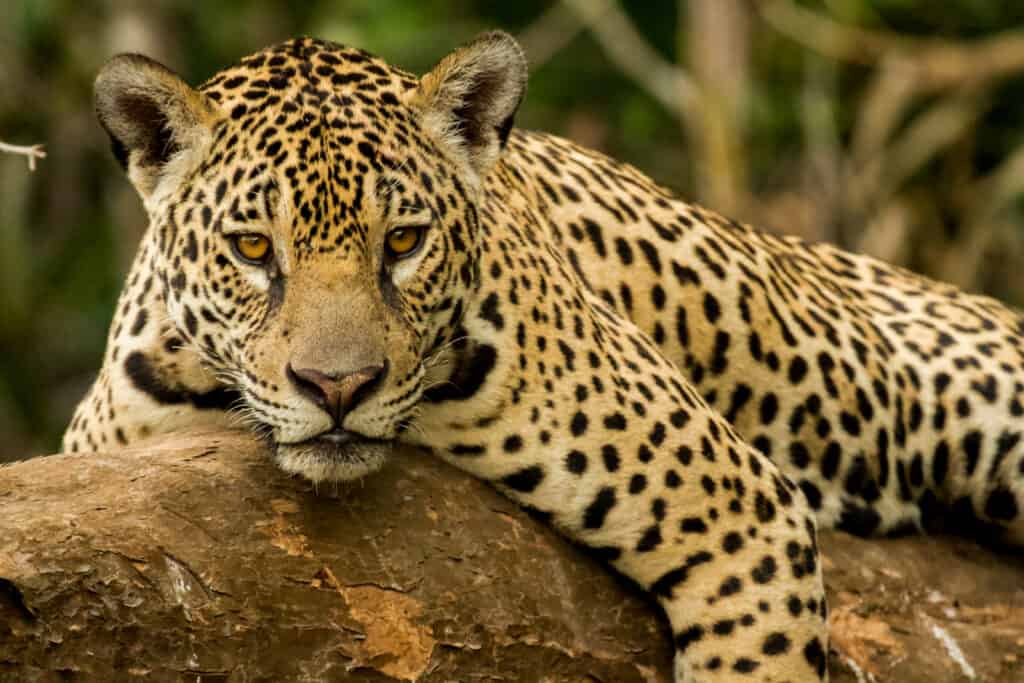
©Pedro Helder Pinheiro/Shutterstock.com
The Largest Jaguar Ever Caught in Arizona
The largest jaguar ever caught in Arizona scored an impressive 18 5/16. The jaguar, which now belongs to the National Museum of Natural History, was caught by hunter Jack Funk in 1924.
Before Funk’s catch, Fred Ott’s 1926 catch had been the largest jaguar ever recorded in Arizona’s history. This catch also belongs to Arizona’s National Museum of Natural History.
The most recent catch, owned by the University of Arizona, was recorded in 1965. This catch by hunter Lawrence McGee scored 15 6/16.

©iStock.com/Patryk_Kosmider
The Largest Jaguar Ever Caught Worldwide
The largest jaguar ever caught worldwide scored an impressive 18 7/16 points. Hunter C.J. McElroy returned home with this impressive catch from Sinaola, Mexico, in 1965.
McElroy, who was hunting under the night’s cover, had to adapt himself to the predator’s surroundings. He had to endure oppressive heat, ticks, foul-smelling swamps, snakes, and chiggers. Nevertheless, McElroy owns the record catch to date.
Jaguar Sightings in Arizona
El Jefe, which means “the boss” in Spanish, is the biggest adult male spotted in Arizona. El Jefe’s name was chosen by Felizardo school students in Valencia in November 2015 during a non-profit conservation contest called Center for Biological Diversity. Several conservation groups and media have also consistently used that name. But some monitoring researchers consider calling him the Santa Rita Jaguar.
In November 2011, he was spotted for the first time at Whetstone Mountains. After several years El Jefe’s image was also captured in Santa Rita Mountains in Arizona.
From 1900, only 62 jaguars have been captured in southwest America.
From November 2011 to 2015, El Jefe was the only Jaguar living in the United States after Macho B’s death in 2009.
According to the animals’ habitat range, Santa Rita and Whetstone mountains are almost 50 miles apart, giving jaguars enough space to roam.
In September 2015, El Jefe was speculated to have gone back to Mexico to the nearest breeding population of the jaguars. But in August 2022, a conservation group announced to have taken his photo in Arizona using a motion-detecting camera.
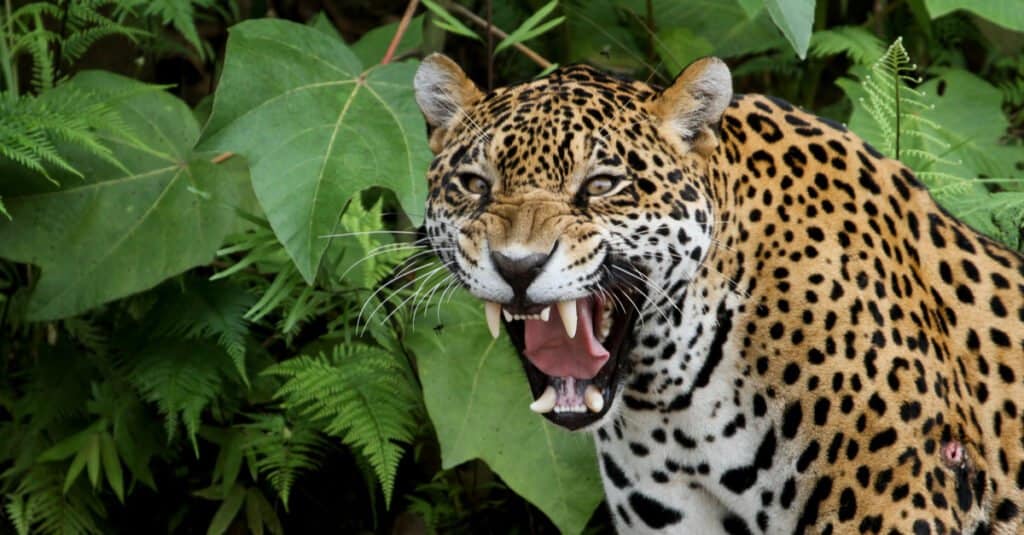
©Adalbert Dragon/Shutterstock.com
The First Sighting
Dinnie Fenn, a cougar hunter, and his daughter were the first to see El Jefe at Whetstone in November 2011. The hunter’s dogs chased El Jefe until he climbed a tree. Fenn took his photos and reached out to the state’s wildlife officials.
Arizona’s Game and Fish Department organized a news conference a few days later. Fenn stated that the jaguar climbed a tree after injuring some dogs. Fenn said that he abandoned his dogs and left the scene. Numerous news outlets published the photographs, but a video taken at the location is not available to the public.
The Santa Rita Mountain Appearance
El Jefe’s pictures were taken in November 2012 at Santa Rita Mountain through camera traps and were similar to Fenn’s images taken a year before.
The Jaguar survey and monitoring project team also set up the camera, an initiative Arizona University leads. As a result, the same spot patterns on the jaguar confirmed to the researchers that it was the same male adult Jaguar.
Pursued Monitoring
After El Jefe’s photos emerged in 2012 in Santa Rita Mountain, some agencies in the area also released a few new pictures and videos.
Since then, the Wild Cat Research, Arizona University’s Conservation Center, and Conservation CATalyst have been at the forefront of the research on the jaguar. Dog Mayke, a Conservation CATalyst, also monitors El Jefe.
El Jefe’s Reappearance at Central Sonora
In August 2022, the Borderlands Linkages Initiative Group, under the coordination of Wildlands Networks, did a fantastic job. The two said it had obtained El Jefe’s two pictures at an undisclosed location in central Sonora. The pictures were taken in November 2022, attracting the attention of the U.S. and Mexican newsrooms.
Unique Facts About Jaguars
It’s not surprising that Arizona is home to desert-dwelling animals, including desert sheep, pronghorn, and jaguars. Even if lions and tigers are giant cats globally, jaguars, too, can grow to massive sizes. The biggest jaguar on record weighed 328 lbs. Here are other unique facts about jaguars.
Iconic Patterns
Jaguars have an iconic painting pattern that might confuse you with leopards, yet, the two species are different.
Habitat
Researching more about jaguars is critical because they are among the most endangered wild animals, and their number has declined over the years. Activities such as illegal hunting, habitat loss, and prey reduction are some primary reasons for the decline in jaguar numbers. Therefore, protecting their habitat is the only way to protect the declining wild cats.
Mexico forests have been the popularly known habitats of the jaguars for many years. Also, it’s possible to spot them in Arizona’s southwestern regions. Forests are the most preferred habitat for the jaguars as they help them avoid heat. In addition, they prefer to rest in large trees.
Jaguars prefer to stay close to the water sources like rivers and wells to have an easy time while quenching their thirst.
Also, they are solitary species and occasionally mate for a short period.
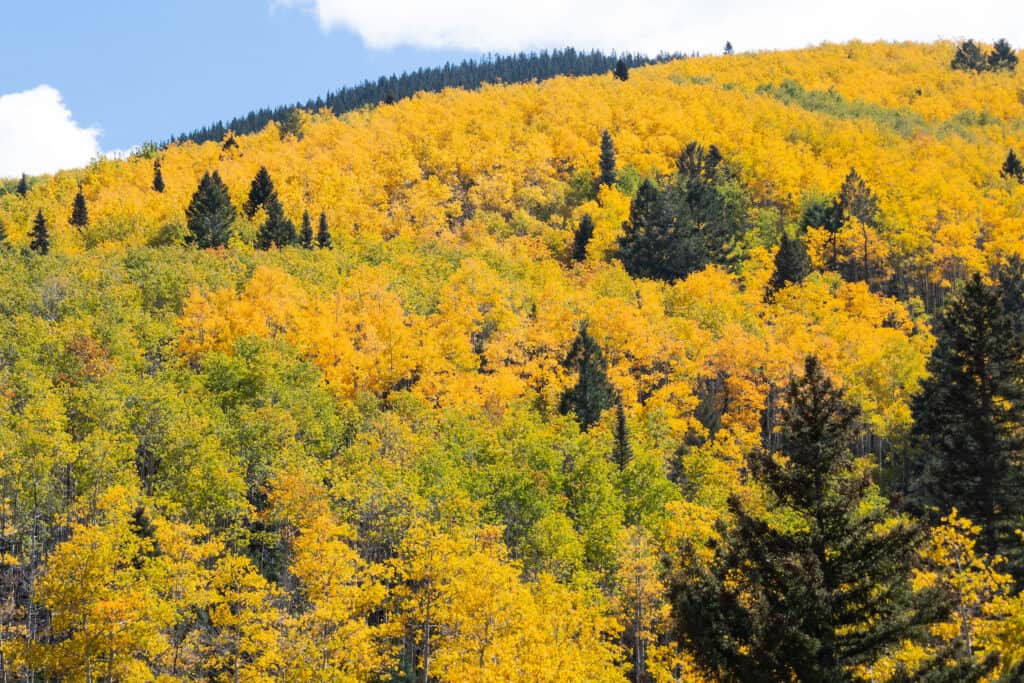
©iStock.com/Williamhc
Physical Attributes
Jaguars’ large skulls, paws, and muscles are critical features that keep them fit to survive in the jungle. In addition, their golden yellow fur is impressive, and every Jaguar’s spot is unique.
The marks on the jaguar’s head and legs are solid but turn into rosette patterns along its body. On rare occasions, they can have black fur covering the whole body.
Diet
Like other cats, jaguars are strictly carnivorous and eat nothing but flesh. However, over 89 animal species have been documented as jaguars’ prey, proving that jaguars are not picky eaters.
Their long claws on the front paw aid them in catching prey. Jaguars’ jaws are strong and enable them to kill the prey, ideally by attacking it by the neck. After crushing the prey, they drug it to their den using their jaws. It is rare for the jaguars to attack humans since they always do their best to avoid them.
Big cats rely primarily on mammalian prey but have been known to eat crocodiles, caimans, and even sea turtles.
When given a chance, jaguars will choose to feed on deer, collared peccaries, and rodents if they can get their hands on them. The jaguar may only require meals once or twice weekly if it can consistently find the food it needs.
There have been confrontations between jaguars and livestock owners because of the animal’s occasional tendency to attack cattle and other livestock.
It is easy to see from a jaguar’s massive canines and ripped physique that it is a strict carnivore that feeds solely on meat. These hunters of great speed and stealth ambush and dismember everything from small mammals and reptiles to large fish and birds.
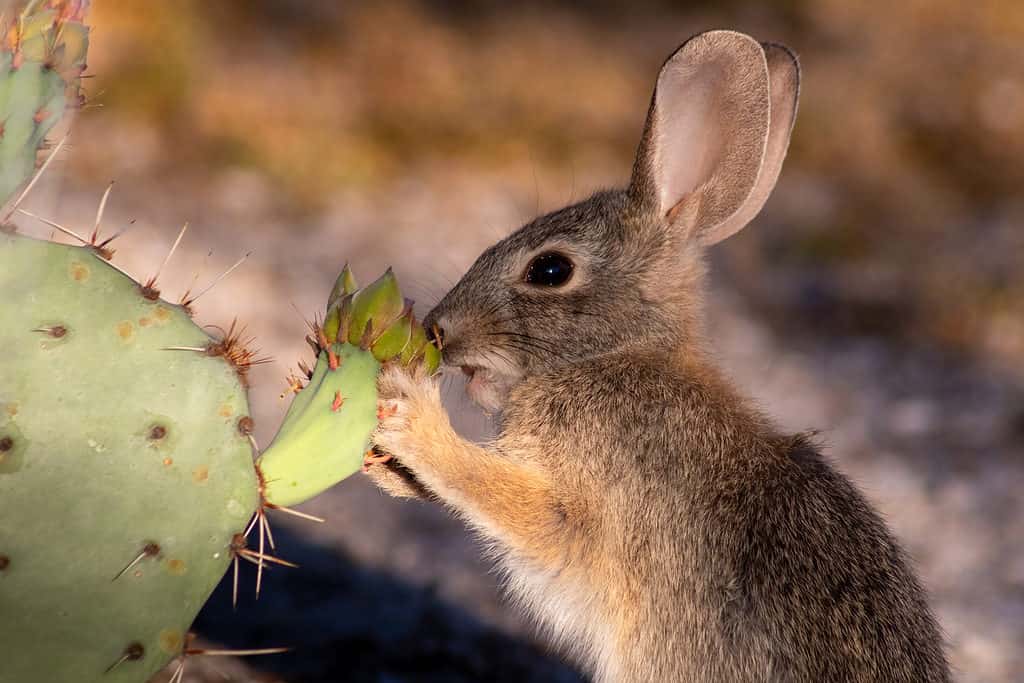
©Charles T. Peden/Shutterstock.com
Here are just a few of the many animals that jaguars prey on:
Since jaguars are not picky eaters, they quickly ambush and incapacitate any tiny animal that gets close enough. In addition, jaguars have no known predators, making them apex predators.
Subspecies
There are nine jaguar subspecies depending on the range they inhabit. They include:
- The Central American Jaguar
- The West Mexico Jaguar
- The East Brazil Jaguar
- The Paraguay Jaguar
- The Northeastern Jaguar
- The Yucatan Peninsula Jaguar
- The Peru Jaguar
- The South American Jaguar
- The Arizona Jaguar
Eyesight
Jaguars have fantastic eye tissue that lets them see clearly in the dark. For this reason, they prefer to hunt at night. Yet, they don’t sleep the whole day; they still go to search for food even when the sun is shining, depending on the region and food scarcity.
Speed
Jaguars move at high speeds and can reach up to 80 miles per hour. But they can only maintain the pace for a short period.
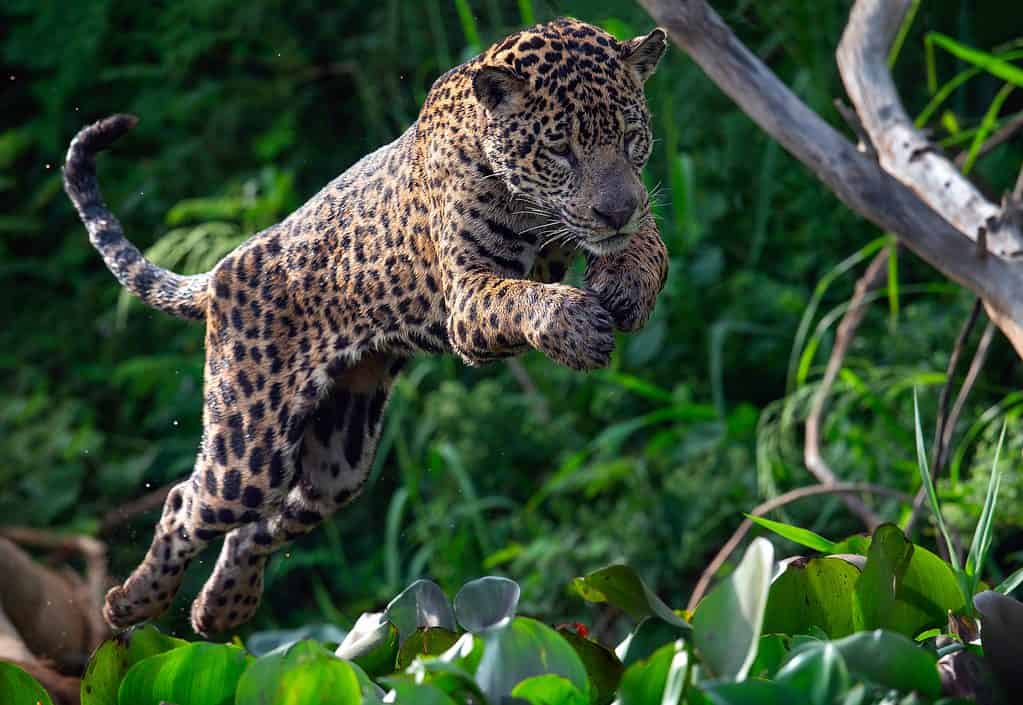
©Sergey Uryadnikov/Shutterstock.com
Territory
Male Jaguars are always larger than females and may grow up to nine feet. Their size is crucial as it enables them to defend themselves from predators. Female Jaguars do not travel far from where they are born. As a result, it is tricky for species expansion. However, their male counterparts roam far to look for mates and new territories.
El Jefe’s appearance at Santa Rita Mountains gave rise to many questions. As a result, numerous organizations oppose Rosemount’s copper mining activities. In addition, the housing projects at Vigneto are also questionable because of their environmental impact and damage to the jaguar habitat.
The barriers in the U.S. and Mexico since 2006 are a hindrance to a female jaguar that may want to expand its territory to Arizona from Sonora’s breeding population in Mexico. Similarly, the ever-increasing infrastructure projects in the U.S. are a primary concern for the endangered cat.
The Homeland Security Department’s non-compliance with environmental laws by building walls is also a big challenge.
Mexico’s Federal Highways number 2 and 15 are also significant hindrances to jaguars’ recovery in the U.S. Since 2010, Highway 2 has been undergoing expansions from Imuris to Janos in Chihuahua.
The Wildlands Network Group has been focusing on preserving the large carnivores’ connectivity, significantly boosting wildlife crossing on the expanded road. As a result, jaguars and other wild animals can roam freely.
Unfortunately, the border wall is a barrier for the Jaguars to reach the United States. Therefore, mitigation measures must be put in place to ensure jaguars’ expansion to the United States.
Offering a habitable place for Jaguars to roam is an excellent way of re-introducing this species that is almost going extinct.
As a result, jaguars and other wild cats will increase in number. Since Jaguars live in the U.S. and Mexico, quality habitat and increasing connectivity between the two countries is the best way to boost their existence.
Bottom Line
Several hunters in Arizona have been yearning for a large jaguar catch to break the 1924 record catch by Jack Funk. Yet jaguars are an endangered species that needs enhanced conservation efforts to save them from extinction. Sightings of this rare cat in Arizona prove this region’s importance to the cat.
The state should, therefore, be on the frontline in ensuring the jaguar’s natural habitat is maintained to boost its numbers.
Up Next…
- 10 Unique Mountains In Arizona
- Discover 15 Types of Rattlesnakes in Arizona
- The 10 Biggest Lakes in Northern Arizona
- Discover the 10 Best National Parks in Arizona
The post Discover The Largest Jaguar Ever Caught in Arizona appeared first on AZ Animals.
from Animal News, Facts, Rankings, and More! - AZ Animals https://ift.tt/lNKiDHZ